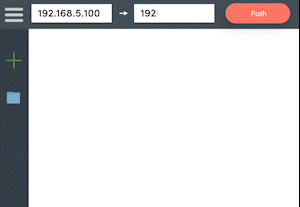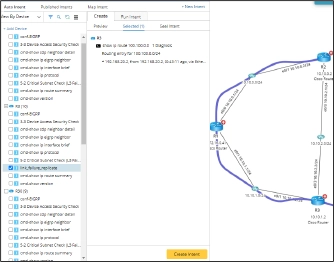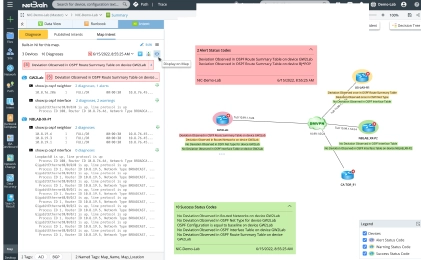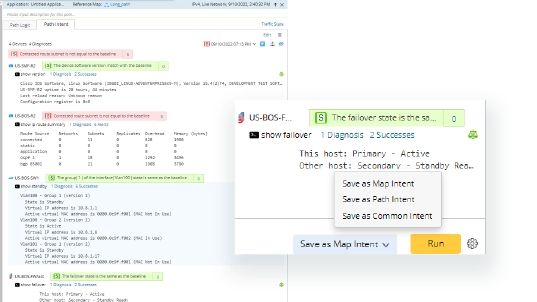What Happens After BGP?
Gaining Full Path Visibility in Hybrid Cloud Networks In the modern enterprise, Border Gateway Protocol (BGP) plays a foundational role in connecting distributed networks. It is the routing protocol that...
Join us at NetBrain LIVE 2025 – Learn, Connect, Grow!
by Kelly Yue Jan 3, 2023
Visio diagrams are still the de facto network map standard in many organizations. The consequences of this manual method can be quite disastrous. Not knowing what’s in your network today can put your business at risk.
Automation is a necessity for the management of complex networks. Dynamic Map as the natural progression for manual diagrams. Like “Google maps” is to road atlases, network Dynamic Maps are the ideal vehicle for documenting the modern network and moving away from the vintage static diagrams.
But, what are these Dynamic Maps? What exactly makes them “dynamic”?
There is a monumental amount of data feeding a Dynamic Map. It is the mathematical rendering of the Digital Twin, a network model derived from live network data. Much like how Google gathers data from many sources to update interactive online maps, the data for Dynamic Maps is cleverly collected through several methods extending beyond SNMP polling for accuracy and completeness.

From online maps, users can view additional landmarks and points of interest by zooming in and out. These points of interest reveal additional details when clicked on.
Network maps’ usefulness is the ability to provide data and context around a problem or task. Dynamic Maps enable the visualization of multiple layers of data. Users zoom in and out to reveal or hide additional details.
Furthermore, data views can be toggled on or off to give engineers an unlimited data in an easily digestible format. Dynamic Maps provide insights into network performance, security and troubleshooting without information overload.

In Dynamic Maps, users can view layers of data by zooming in and out of the map. Users can drill into each device for additional details.
When troubleshooting requires data from multiple sources and tools, engineers often navigate through several windows and screens to gather it. It’s easy to lose the context and it becomes difficult to correlate data effectively.

Dynamic Maps integrate seamlessly with existing workflows and tools to serve as a shared console for a single, contextual view.
With Dynamic Maps, third-party API integration keeps all the necessary data on the same map. This “Single Pane of Glass” makes correlation of information from network monitoring, trouble-ticketing, CMDB, and event management systems much easier.
It makes no sense to create the ideal map for a specific task only for it to be obsolete as soon as something in the network changes. The beauty of the Digital Twin behind Dynamic Maps comes as changes are carried out in the network. Changes are updated automatically on the map from live network data precisely at the moment they are needed or every time they are opened.
Every IT workflow is enhanced with visualization. However, even the best-kept network diagram repositories seldom provide the map needed for a specific corner of the network.
A slow application may traverse devices located in separate data centers. Multiple maps of the data centers with irrelevant devices is not very helpful. Troubleshooting requires one map visualizing the entire application path, from source to destination, across data centers.
A network Dynamic Map offers the ability to generate a A-to-B path on demand, in seconds. The map adapts dynamically to the task at hand, helping to save the day.
Dynamic Maps provide a global view of the network enabling engineers to drill down site-by-site, zoom in to reveal connection details between sites, and see comparisons between live network data and previous benchmarks.

From this global overview map, a Dynamic Map allows the user to zoom into the site, revealing additional levels of detail and the connections between other sites.
Dynamic Maps capture the Intent of your network by merging network behaviors and policies right on the map. Pre-defined Intents are visualized on-demand to see diagnosis data. Deltas between your live network and your Intent are visually marked for further investigation.


When troubleshooting any application path, users can compare against its “Golden” path and overlay the path Intent results.

Why not evaluate the power of Dynamic Maps with no-code intent-based automation?
Gaining Full Path Visibility in Hybrid Cloud Networks In the modern enterprise, Border Gateway Protocol (BGP) plays a foundational role in connecting distributed networks. It is the routing protocol that...
Your Network Automation Is Holding You Back Network teams across industries are caught in an automation paradox. While 64% of enterprises rely on homegrown scripts and open-source tools like Ansible,...
NetBrain CEO Insights from ISMG Interview at RSAC How Agentic AI decodes network intent to automate diagnosis In the rapidly evolving world of IT infrastructure, preventing recurring network outages...
We use cookies to personalize content and understand your use of the website in order to improve user experience. By using our website you consent to all cookies in accordance with our privacy policy.